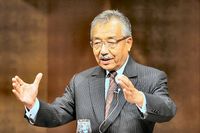


Toshio Matsuda, Commentator & Intl Economist
Straight from the Shoulder
Official Website : http://www.chokugen.com/e/
E-mail : masuda@sunraworld.com
FAX: 011 81 3 5965-0064
BackNumber is HERE!
Seeing Through the Intentions of Federal Reserve Chairman, Ben Bernanke
It is no exaggeration to say that the U.S. economy is controlled by the Federal Reserve Board (FRB), or more accurately, its chairman Ben Bernanke.
My forecast so far has always been that both the stock prices and exchange rates will be range-bound until October, with a slight increase in the average stock price and the value of the yen, though with market oscillations. I believe that the turning point will come on September 18 when the Federal Open Market Committee (FMOC) meets. I have carefully explained that there will be a reasonable, but not sudden, upward trend in the yen and stock prices, depending on the decision of the FMOC... The market has moved as I expected to this point.
It is a fact that the U.S. market is affected by the FRBfs monetary policies and so we need to understand just who is Ben Bernanke. Before he became chairman on February 1, 2006, he was considered by specialists to be an inflation-targeting theorist, though not by choice.
It probably annoys him that people interpret the word gtargetingh as the policy of manipulating the inflation. In March 2005, however, he said in a lecture, gIt is forecast that the core PCE (personal consumption expenditure except food and energy) for 2005 will increase at a rate that is slightly higher than the 1.6% for 2004. The increase will remain within my comfort zone, which is one to two percent over the previous year.h
In the Senate Banking Committee, there are many opponents of inflation targeting, and Bernanke does not want to imply a target rate by mentioning his gcomfort zone.h In any event, his statements in the past clearly indicate that he is an inflation fighter, and when it comes to attaining FRBfs two main goals, his focus is on price stability rather than employment optimization.
An Ideal Inflation Target
Personally, I am against the central bank setting a target range for inflation as a policy. It is preferable to allow the market to react within the target range that the market itself autonomously sets based on the ideal inflation rate as determined by the central bank while taking into consideration the current economic fundamentals. This ideal inflation rate is calculated using the inflation rates forecast by the central bank on both short- and long-term bases.
The central bank should not set an inflation target. Rather, it should appear as if the inflation target referenced by the central bank was reached as a result of the autonomous reaction of the market.
It requires the charisma of the governor of the central bank or the chairman of the Federal Reserve for the marketfs autonomy to take effect. In other words, it is important that the market takes their word at face value. For instance, Bernankefs speech about the gcomfort zoneh did not represent his theory about inflation targeting, nor did he mean it to. The market, however, did what it did, based on the figure that he had mentioned. This is symbolic of what is called the dialogue between the central bank and the market.
The European Central Bank (ECB) has set a two-percent increase as the definition of price stability, the European equivalent of the US inflation target only with a different name. When the price index increases by a percentage higher than 2%, the ECB raises the interest rate almost automatically. Meanwhile, on the employment front, there are more countries that suffer from double-digit jobless rates.. This means that the inflation target is at odds with employment.
Long-Awaited September 18 Meeting
In response to the most recent credit crunch, the FRB lowered the official discount rate, which increased the gap between the Federal Fund rate (FF) and the discount rate to more than one percent, which has been maintained as a baseline in the past. To fill the gap, FOMC must lower the FF by 0.5% on September 18. If the Committee decides to lower by only 0.25%, Bernanke must convince the market that it really does not need the additional 0.25% cut by paying some kind of lip service to the strength of the economy.
Whether or not the market gains confidence depends on the economic indices that are to be announced in early September for housing and consumption. The August report on the number of new housing units started in July significantly exceeded the forecast, but both housing and consumption are expected to take a dive in August, partly influenced by the sharp decline in the stock prices in the same month.
I am sure that Bernanke, an inflation fighter, wants to restrict the lowering of interest rates to 0.25% by insisting that the August drop in consumption and housing was temporary. From the standpoint of the principle of maintaining a one-percent gap between the official discount rate and FF, the interest rate would still be higher by a quarter of a percent.
If the market buys Bernankefs line, both the Nikkei and Dow Jones will experience a slow recovery with baselines of 16,000 and 13,000 points respectively, without a spike. If something like the 1998 Long-Term Capital Management (LTCM) liquidity crisis occurs, it will be necessary to demand a half a percent cut, which will be a difficult choice for Bernanke as an inflation fighter.
Anyone wanting to redistribute Straight from the Shoulder pieces or excerpts from the texts should direct their request in advance to the Toshio Matsuda Office at Sunraworld, Ltd. (Tel: 81-(0)3-3955-2121).